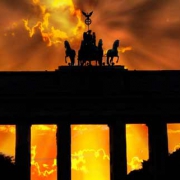The Pharaoh dimension – LNG in Egypt
One in 3 Arabs worldwide lives on the banks of the Nile river? That makes the oldest culture on earth the Arab heavyweight.
Unfortunately, modern Egypt has made the headlines more than once in the very recent past. Not really the kind of news that we would wish this tormented country but believe it or not, Egypt may also become the new energy powerhouse of North Africa.
Big populations also mean lots of movement of people and goods. And almost all of it moves up and down the narrow Nile valley. This makes the valley a logistical artery with no equal in Africa. But all this traffic also consumes pharaonic amounts of diesel fuel which scorch the sky and poisons people’s lungs. As a side effect, its hugely expensive to the Egyptian state as most of this fuel is subsidized.
Money, that Egypt can ill afford to squander – especially in those hard times. One might be forgiven to think that during such hardship, the transformation of Egypt into and a green country must be a foolish endeavor. Look again.
Natural Gas is the cleanest burning fossil fuel. It’s not just a bit cleaner than all of its cousins. It’s a world onto itself. Most of the nasty stuff that leaves tailpipes after diesel combustion never occurs in the first place when Natural Gas is used. It’s the ultimate economical fuel that saves the planet.
But for those who are Natural Gas producers, it’s also one of the cheapest fuels they can use. Crude oil responds to the world market. The Natural Gas world (and yes that’s also true for LNG) is still regional in its nature.
This means that if you import oil and/or oil products, you pay international prices which are high and yes, USD 60 Dollar Brent is expensive. Reducing costly imports of crude and fuels must, therefore, be high on the government agenda.
If you are an oil producer yourself and at the same time you’re a copious consumer of oil, you either export crude and still import refined products if your refinery capacity cannot keep pace with the burgeoning consumption in the country or you could at least sell more high price product on international markets balancing the countries household. Don’t worry, the oil price is going to go up again.
Turn it the way you want it – consuming oil products is going to cost you dearly and reducing consumption of the dirty, expensive stuff must be of paramount importance.
Egypt is in such a position. It produces oil and gas but it also uses copious amounts of oil products itself. Natural Gas has made inroads in electricity production and also in industrial use but it is largely absent from the transport sector, a voracious gobbler of the flammable stuff.
Every other country would struggle with the introduction of LNG as a fuel as we all know the problem. Chicken and egg – one needs a wide and spread out system of fueling stations in order to be sure to be able to fuel a vehicle once it’s bought. But building up that system of stations in the first place is expensive and wasteful as they are not going to have a lot of business to thrive on for a number of years.
In other countries, you have no other choice than starting small with fleet vehicle pilots and then spread slowly hoping the flame would catch on. Not so in Egypt.
Most of the population lives in the narrow Nile valley with the remainder concentrated on the coasts, the Delta and a string of oasis in the Western desert. That’s not an awful lot of surface to cover for such a huge population. And most of the trucks just make the North – South – North trip in order to bring things to and fro the North to the South.
With all those vehicles going up and down the Nile River, a few strategically placed LNG fuelling stations would be enough to cover much of the country. And many of the trucks never do anything else than hauling from North to South and back.
That’s a great fleet of vehicles moving in very predictable patterns.
Even a very small liquefier, let’s say a 100 metric tons a day nitrogen expander produces a little less than 100.000 liters of Diesel Liter Equivalent in LNG per day. Depending on the actual consumption of the vehicles, one liquefier would be able to fuel a fleet of between 200 and 250 heavy duty vehicles.
And in Egypt, such a fleet very likely passes through the narrow Nile valley every day. And even more.
This is great critical mass of vehicles moving through bottlenecks that would make excellent fuelling points. A few points would make maximum impact. Little investment – great effect.
Now, Egypt also flares gas – yes, readers of this blog know the drill or, at least, won’t be surprised but I will repeat for those new to here and also because I love the rationale.
Flaring gas is a waste of resources and also spoils the environment. Flared gas can be liquefied in small-scale liquefaction plants in order to be used for vehicle fuel. This will lower the fuel price in the region concerned, insulate it also from price shocks in the international oil market and help the country bolster its green credentials.
It would save money and the environment by the same token and Egypt would be a prime contender for kick starting the LNG as a fuel economy in this part of the world. This narrow stretch through the desert provides almost ideal conditions for conversion and who knows; maybe in the future, we will see Egyptian cities without the sot from diesel emissions scorching buildings and people’s lungs.
Egypt might finally become the untarnished pearl it once was again.














Leave a Reply
Want to join the discussion?Feel free to contribute!